2025届高三英语二轮复习2024年新课标I卷CD篇阅读解析 公开课课件(共14张)
文档属性
| 名称 | 2025届高三英语二轮复习2024年新课标I卷CD篇阅读解析 公开课课件(共14张) | 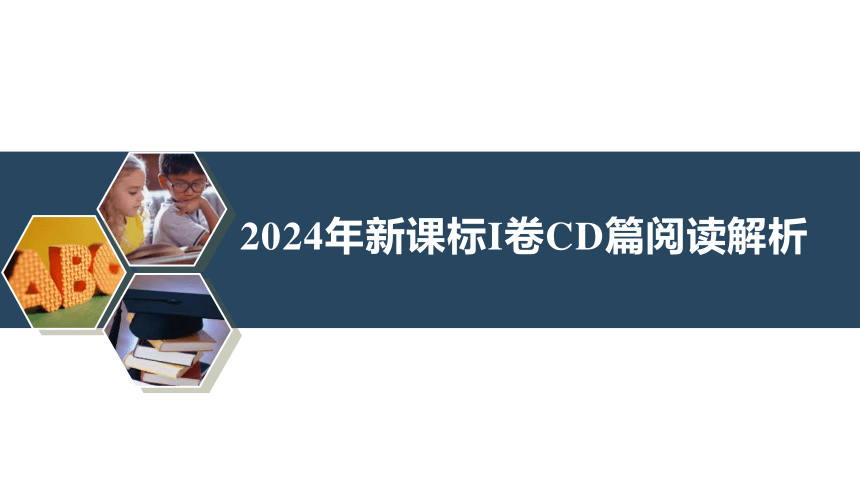 | |
| 格式 | pptx | ||
| 文件大小 | 999.8KB | ||
| 资源类型 | 教案 | ||
| 版本资源 | 人教版(2019) | ||
| 科目 | 英语 | ||
| 更新时间 | 2024-11-10 10:46:39 | ||
图片预览

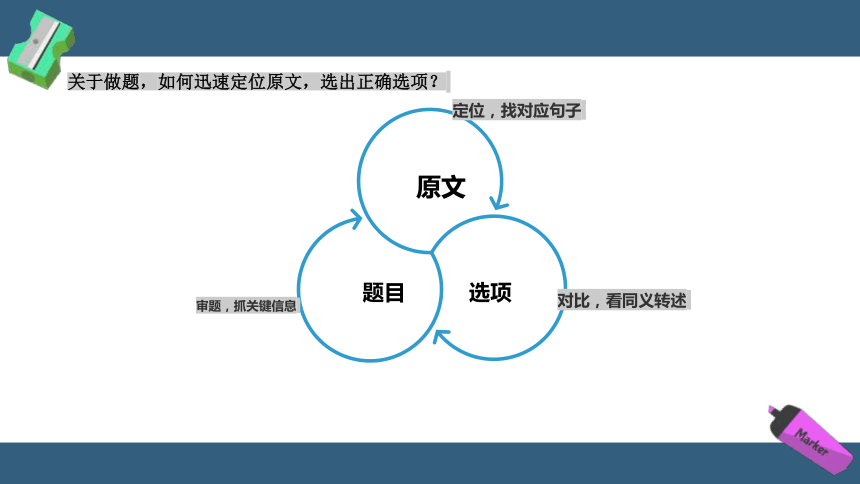
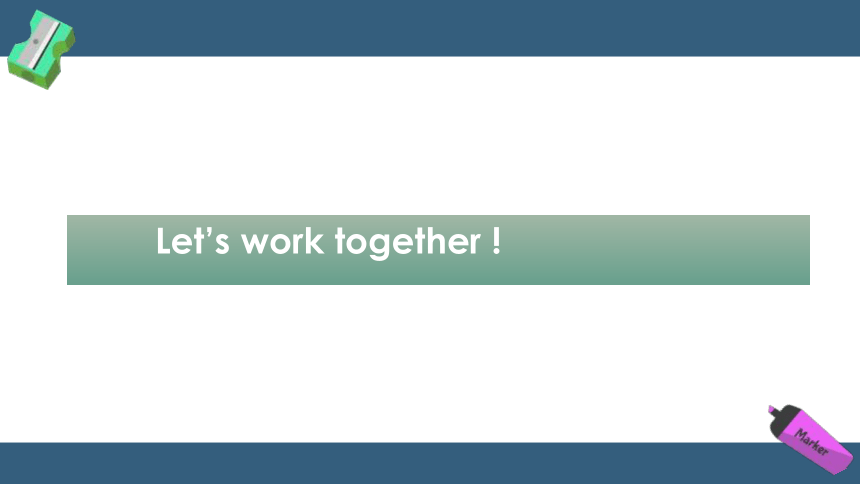
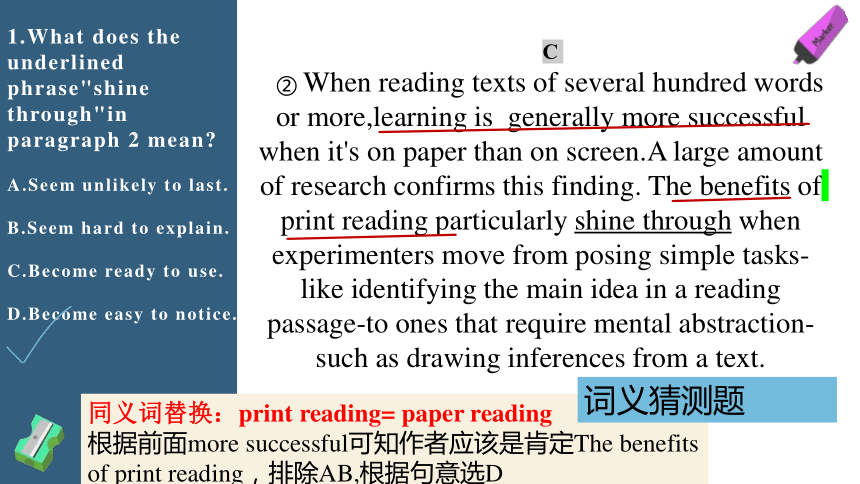
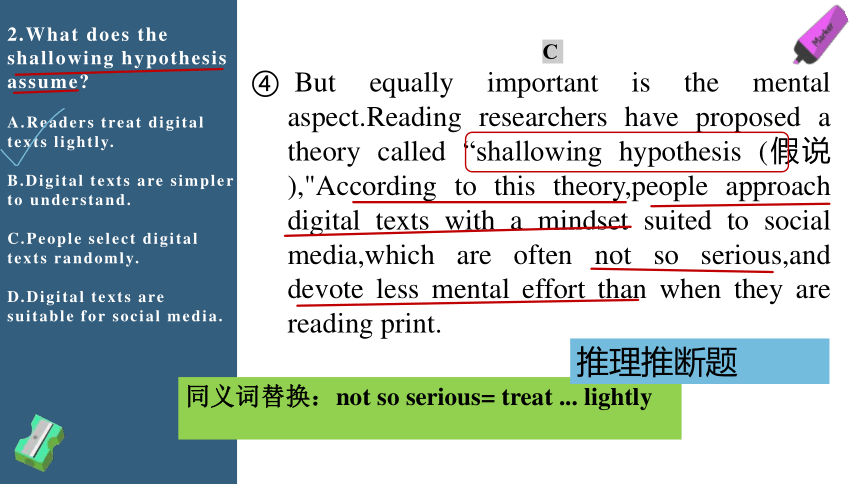
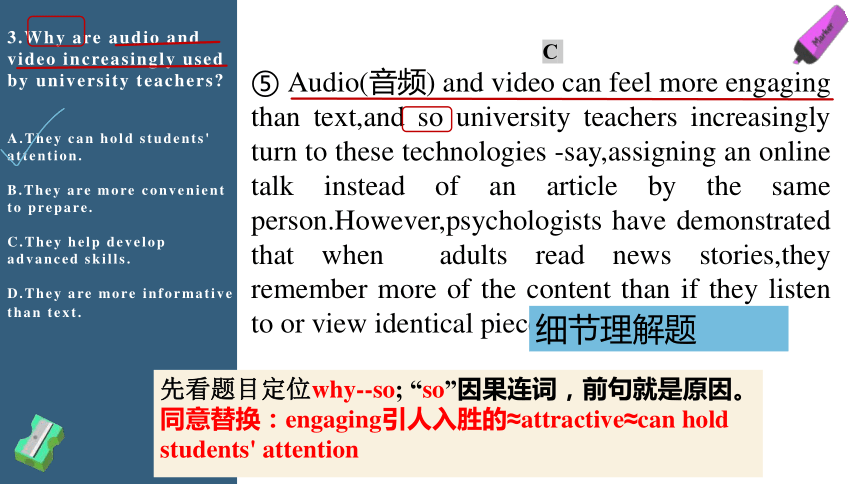
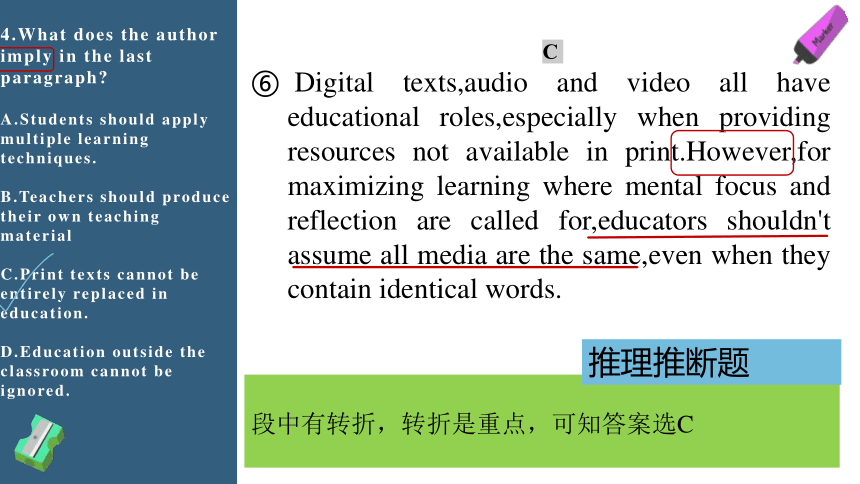
文档简介
(共14张PPT)
2024年新课标I卷CD篇阅读解析
关于做题,如何迅速定位原文,选出正确选项?
定位,找对应句子
对比,看同义转述
审题,抓关键信息
原文
题目
选项
Let’s work together !
1.What does the underlined phrase"shine through"in paragraph 2 mean
A.Seem unlikely to last.
B.Seem hard to explain.
C.Become ready to use.
D.Become easy to notice.
C
② When reading texts of several hundred words or more,learning is generally more successful when it's on paper than on screen.A large amount of research confirms this finding. The benefits of print reading particularly shine through when experimenters move from posing simple tasks-like identifying the main idea in a reading passage-to ones that require mental abstraction-such as drawing inferences from a text.
同义词替换:print reading= paper reading
根据前面more successful可知作者应该是肯定The benefits of print reading,排除AB,根据句意选D
词义猜测题
2.What does the shallowing hypothesis assume
A.Readers treat digital texts lightly.
B.Digital texts are simpler to understand.
C.People select digital texts randomly.
D.Digital texts are suitable for social media.
C
But equally important is the mental aspect.Reading researchers have proposed a theory called “shallowing hypothesis (假说),"According to this theory,people approach digital texts with a mindset suited to social media,which are often not so serious,and devote less mental effort than when they are reading print.
同义词替换:not so serious= treat ... lightly
推理推断题
3.Why are audio and video increasingly used by university teachers
A.They can hold students' attention.
B.They are more convenient to prepare.
C.They help develop advanced skills.
D.They are more informative than text.
C
Audio(音频) and video can feel more engaging
than text,and so university teachers increasingly turn to these technologies -say,assigning an online talk instead of an article by the same person.However,psychologists have demonstrated that when adults read news stories,they remember more of the content than if they listen to or view identical pieces.
先看题目定位why--so; “so”因果连词,前句就是原因。
同意替换:engaging引人入胜的≈attractive≈can hold students' attention
细节理解题
4.What does the author imply in the last paragraph
A.Students should apply multiple learning techniques.
B.Teachers should produce their own teaching material
C.Print texts cannot be entirely replaced in education.
D.Education outside the classroom cannot be ignored.
C
Digital texts,audio and video all have educational roles,especially when providing resources not available in print.However,for maximizing learning where mental focus and reflection are called for,educators shouldn't assume all media are the same,even when they contain identical words.
段中有转折,转折是重点,可知答案选C
推理推断题
Is comprehension the same whether a person reads a text onscreen or on paper And are listening to and viewing content as effective as reading the written word when covering the same material The answers to both questions are often “no.” The reasons relate to a variety of factors,including reduced concentration,an entertainment mindset(心态)and a tendency to multitask while consuming digital content.
When reading texts of several hundred words or more,learning is generally more successful when it's on paper than onscreen.A large amount of research confirms this finding. The benefits of print reading particularly shine through when experimenters move from posing simple tasks-like identifying the main idea in a reading passage-to ones that require mental abstraction-such as drawing inferences from a text.
The differences between print and digital reading results are partly related to paper's physical properties.With paper,there is a literal laying on of hands,along with the visual geography of distinct pages.People often link their memory of what they've read to how far into the book it was or where it was on the page.
But equally important is the mental aspect.Reading researchers have proposed a theory called "shallowing hypothesis (假说),"According to this theory,people approach digital texts with a mindset suited to social media,which are often not so serious,and devote less mental effort than when they are reading print.
Audio(音频) and video can feel more engaging than text,and so university teachers increasingly turn to these technologies -say,assigning an online talk instead of an article by the same person.However,psychologists have demonstrated that when adults read news stories,they remember more of the content than if they listen to or view identical pieces.
Digital texts,audio and video all have educational roles,especially when providing resources not available in print.However,for maximizing learning where mental focus and reflection are called for,educators shouldn't assume all media are the same,even when they contain identical words.
P1-2提出问题:屏幕阅读与纸质阅读在理解力上存在差异,纸质材料上的阅读更有效。
P3解释原因(一):纸张的物理属性(触感和地理位置)有助于记忆内容。
P4-5解释原因(二):心理因素也是同等重要的原因:数字文本阅读的投入比印刷文本少。
P6总结:教育者不应认为所有媒体都是一样的。
show time
Show your abilities !
D
1.In the race to document the species on Earth before they go extinct, researchers and citizen scientists have collected billions of records. Today, most records of biodiversity are often in the form of photos, videos, and other digital records. Though they are useful for detecting shifts in the number and variety of species in an area, a new Stanford study has found that this type of record is not perfect.
2.“With the rise of technology it is easy for people to make observations of different species with the aid of a mobile application,” said Barnabas Daru, who is lead author of the study and assistant professor of biology in the Stanford School of Humanities and Sciences. “These observations now outnumber the primary data that comes from physical specimens (标本), and since we are increasingly using observational data to investigate how species are responding to global change, I wanted to know: Are they usable ”
3.Using a global dataset of 1.9 billion records of plants, insects, birds, and animals, Daru and his team tested how well these data represent actual global biodiversity patterns.
4.“We were particularly interested in exploring the aspects of sampling that tend to bias (使有偏差) data, like the greater likelihood of a citizen scientist to take a picture of a flowering plant instead of the grass right next to it,” said Daru.
1. What do we know about the records of species collected now
A. They are becoming outdated.
B. They are mostly in electronic form.
C. They are limited in number.
D. They are used for public exhibition.
D
1.In the race to document the species on Earth before they go extinct, researchers and citizen scientists have collected billions of records. Today, most records of biodiversity are often in the form of photos, videos, and other digital records. Though they are useful for detecting shifts in the number and variety of species in an area, a new Stanford study has found that this type of record is not perfect.
2.“With the rise of technology it is easy for people to make observations of different species with the aid of a mobile application,” said Barnabas Daru, who is lead author of the study and assistant professor of biology in the Stanford School of Humanities and Sciences. “These observations now outnumber the primary data that comes from physical specimens (标本), and since we are increasingly using observational data to investigate how species are responding to global change, I wanted to know: Are they usable ”
3.Using a global dataset of 1.9 billion records of plants, insects, birds, and animals, Daru and his team tested how well these data represent actual global biodiversity patterns.
4.“We were particularly interested in exploring the aspects of sampling that tend to bias (使有偏差) data, like the greater likelihood of a citizen scientist to take a picture of a flowering plant instead of the grass right next to it,” said Daru.
2. What does Daru’s study focus on
A. Threatened species.
B. Physical specimens.
C. Observational data.
D. Mobileapplications.
3. What has led to the biases according to the study
A. Mistakes in data analysis.
B. Poor quality of uploaded pictures.
C. Improper way of sampling.
D. Unreliable data collection devices.
5.Their study revealed that the large number of observation-only records did not lead to better global coverage. Moreover, these data are biased and favor certain regions, time periods, and species. This makes sense because the people who get observational biodiversity data on mobile devices are often citizen scientists recording their encounters with species in areas nearby. These data are also biased toward certain species with attractive or eye-catching features.
6. What can we do with the imperfect datasets of biodiversity
7. “Quite a lot,” Daru explained. “Biodiversity apps can use our study results to inform users of oversampled areas and lead them to places – and even species – that are not well-sampled. To improve the quality of observational data, biodiversity apps can also encourage users to have an expert confirm the identification of their uploaded image.”
4. What is Daru’s suggestion for biodiversity apps
A. Review data from certain areas.
B. Hire experts to check the records.
C. Confirm the identity of the users.
D. Give guidance to citizen scientists.
5.Their study revealed that the large number of observation-only records did not lead to better global coverage. Moreover, these data are biased and favor certain regions, time periods, and species. This makes sense because the people who get observational biodiversity data on mobile devices are often citizen scientists recording their encounters with species in areas nearby. These data are also biased toward certain species with attractive or eye-catching features.
6. What can we do with the imperfect datasets of biodiversity
7. “Quite a lot,” Daru explained. “Biodiversity apps can use our study results to inform users of oversampled areas and lead them to places – and even species – that are not well-sampled. To improve the quality of observational data, biodiversity apps can also encourage users to have an expert confirm the identification of their uploaded image.”
Let’s work hard
to achieve success!
Homework:
Finish the exercises in
your learning guide paper.
2024年新课标I卷CD篇阅读解析
关于做题,如何迅速定位原文,选出正确选项?
定位,找对应句子
对比,看同义转述
审题,抓关键信息
原文
题目
选项
Let’s work together !
1.What does the underlined phrase"shine through"in paragraph 2 mean
A.Seem unlikely to last.
B.Seem hard to explain.
C.Become ready to use.
D.Become easy to notice.
C
② When reading texts of several hundred words or more,learning is generally more successful when it's on paper than on screen.A large amount of research confirms this finding. The benefits of print reading particularly shine through when experimenters move from posing simple tasks-like identifying the main idea in a reading passage-to ones that require mental abstraction-such as drawing inferences from a text.
同义词替换:print reading= paper reading
根据前面more successful可知作者应该是肯定The benefits of print reading,排除AB,根据句意选D
词义猜测题
2.What does the shallowing hypothesis assume
A.Readers treat digital texts lightly.
B.Digital texts are simpler to understand.
C.People select digital texts randomly.
D.Digital texts are suitable for social media.
C
But equally important is the mental aspect.Reading researchers have proposed a theory called “shallowing hypothesis (假说),"According to this theory,people approach digital texts with a mindset suited to social media,which are often not so serious,and devote less mental effort than when they are reading print.
同义词替换:not so serious= treat ... lightly
推理推断题
3.Why are audio and video increasingly used by university teachers
A.They can hold students' attention.
B.They are more convenient to prepare.
C.They help develop advanced skills.
D.They are more informative than text.
C
Audio(音频) and video can feel more engaging
than text,and so university teachers increasingly turn to these technologies -say,assigning an online talk instead of an article by the same person.However,psychologists have demonstrated that when adults read news stories,they remember more of the content than if they listen to or view identical pieces.
先看题目定位why--so; “so”因果连词,前句就是原因。
同意替换:engaging引人入胜的≈attractive≈can hold students' attention
细节理解题
4.What does the author imply in the last paragraph
A.Students should apply multiple learning techniques.
B.Teachers should produce their own teaching material
C.Print texts cannot be entirely replaced in education.
D.Education outside the classroom cannot be ignored.
C
Digital texts,audio and video all have educational roles,especially when providing resources not available in print.However,for maximizing learning where mental focus and reflection are called for,educators shouldn't assume all media are the same,even when they contain identical words.
段中有转折,转折是重点,可知答案选C
推理推断题
Is comprehension the same whether a person reads a text onscreen or on paper And are listening to and viewing content as effective as reading the written word when covering the same material The answers to both questions are often “no.” The reasons relate to a variety of factors,including reduced concentration,an entertainment mindset(心态)and a tendency to multitask while consuming digital content.
When reading texts of several hundred words or more,learning is generally more successful when it's on paper than onscreen.A large amount of research confirms this finding. The benefits of print reading particularly shine through when experimenters move from posing simple tasks-like identifying the main idea in a reading passage-to ones that require mental abstraction-such as drawing inferences from a text.
The differences between print and digital reading results are partly related to paper's physical properties.With paper,there is a literal laying on of hands,along with the visual geography of distinct pages.People often link their memory of what they've read to how far into the book it was or where it was on the page.
But equally important is the mental aspect.Reading researchers have proposed a theory called "shallowing hypothesis (假说),"According to this theory,people approach digital texts with a mindset suited to social media,which are often not so serious,and devote less mental effort than when they are reading print.
Audio(音频) and video can feel more engaging than text,and so university teachers increasingly turn to these technologies -say,assigning an online talk instead of an article by the same person.However,psychologists have demonstrated that when adults read news stories,they remember more of the content than if they listen to or view identical pieces.
Digital texts,audio and video all have educational roles,especially when providing resources not available in print.However,for maximizing learning where mental focus and reflection are called for,educators shouldn't assume all media are the same,even when they contain identical words.
P1-2提出问题:屏幕阅读与纸质阅读在理解力上存在差异,纸质材料上的阅读更有效。
P3解释原因(一):纸张的物理属性(触感和地理位置)有助于记忆内容。
P4-5解释原因(二):心理因素也是同等重要的原因:数字文本阅读的投入比印刷文本少。
P6总结:教育者不应认为所有媒体都是一样的。
show time
Show your abilities !
D
1.In the race to document the species on Earth before they go extinct, researchers and citizen scientists have collected billions of records. Today, most records of biodiversity are often in the form of photos, videos, and other digital records. Though they are useful for detecting shifts in the number and variety of species in an area, a new Stanford study has found that this type of record is not perfect.
2.“With the rise of technology it is easy for people to make observations of different species with the aid of a mobile application,” said Barnabas Daru, who is lead author of the study and assistant professor of biology in the Stanford School of Humanities and Sciences. “These observations now outnumber the primary data that comes from physical specimens (标本), and since we are increasingly using observational data to investigate how species are responding to global change, I wanted to know: Are they usable ”
3.Using a global dataset of 1.9 billion records of plants, insects, birds, and animals, Daru and his team tested how well these data represent actual global biodiversity patterns.
4.“We were particularly interested in exploring the aspects of sampling that tend to bias (使有偏差) data, like the greater likelihood of a citizen scientist to take a picture of a flowering plant instead of the grass right next to it,” said Daru.
1. What do we know about the records of species collected now
A. They are becoming outdated.
B. They are mostly in electronic form.
C. They are limited in number.
D. They are used for public exhibition.
D
1.In the race to document the species on Earth before they go extinct, researchers and citizen scientists have collected billions of records. Today, most records of biodiversity are often in the form of photos, videos, and other digital records. Though they are useful for detecting shifts in the number and variety of species in an area, a new Stanford study has found that this type of record is not perfect.
2.“With the rise of technology it is easy for people to make observations of different species with the aid of a mobile application,” said Barnabas Daru, who is lead author of the study and assistant professor of biology in the Stanford School of Humanities and Sciences. “These observations now outnumber the primary data that comes from physical specimens (标本), and since we are increasingly using observational data to investigate how species are responding to global change, I wanted to know: Are they usable ”
3.Using a global dataset of 1.9 billion records of plants, insects, birds, and animals, Daru and his team tested how well these data represent actual global biodiversity patterns.
4.“We were particularly interested in exploring the aspects of sampling that tend to bias (使有偏差) data, like the greater likelihood of a citizen scientist to take a picture of a flowering plant instead of the grass right next to it,” said Daru.
2. What does Daru’s study focus on
A. Threatened species.
B. Physical specimens.
C. Observational data.
D. Mobileapplications.
3. What has led to the biases according to the study
A. Mistakes in data analysis.
B. Poor quality of uploaded pictures.
C. Improper way of sampling.
D. Unreliable data collection devices.
5.Their study revealed that the large number of observation-only records did not lead to better global coverage. Moreover, these data are biased and favor certain regions, time periods, and species. This makes sense because the people who get observational biodiversity data on mobile devices are often citizen scientists recording their encounters with species in areas nearby. These data are also biased toward certain species with attractive or eye-catching features.
6. What can we do with the imperfect datasets of biodiversity
7. “Quite a lot,” Daru explained. “Biodiversity apps can use our study results to inform users of oversampled areas and lead them to places – and even species – that are not well-sampled. To improve the quality of observational data, biodiversity apps can also encourage users to have an expert confirm the identification of their uploaded image.”
4. What is Daru’s suggestion for biodiversity apps
A. Review data from certain areas.
B. Hire experts to check the records.
C. Confirm the identity of the users.
D. Give guidance to citizen scientists.
5.Their study revealed that the large number of observation-only records did not lead to better global coverage. Moreover, these data are biased and favor certain regions, time periods, and species. This makes sense because the people who get observational biodiversity data on mobile devices are often citizen scientists recording their encounters with species in areas nearby. These data are also biased toward certain species with attractive or eye-catching features.
6. What can we do with the imperfect datasets of biodiversity
7. “Quite a lot,” Daru explained. “Biodiversity apps can use our study results to inform users of oversampled areas and lead them to places – and even species – that are not well-sampled. To improve the quality of observational data, biodiversity apps can also encourage users to have an expert confirm the identification of their uploaded image.”
Let’s work hard
to achieve success!
Homework:
Finish the exercises in
your learning guide paper.
